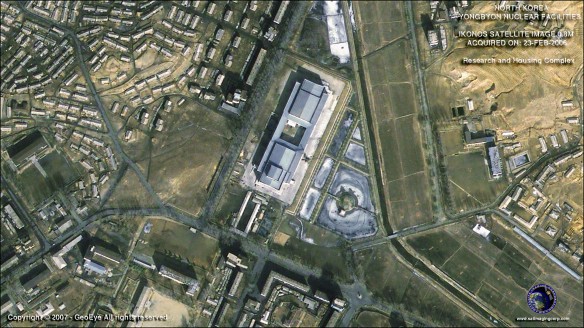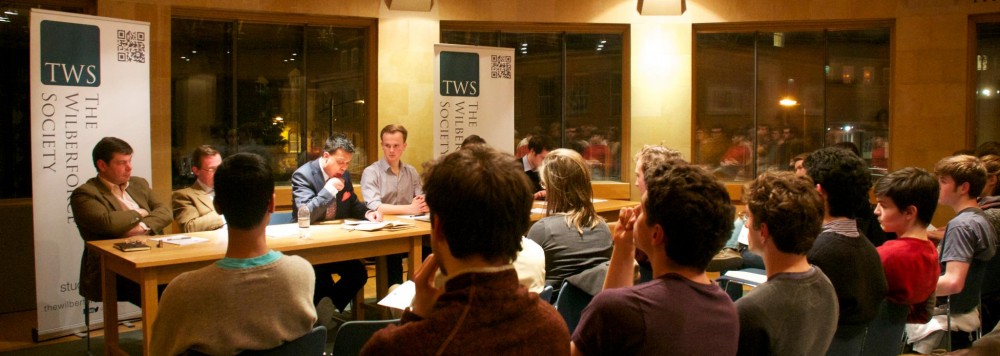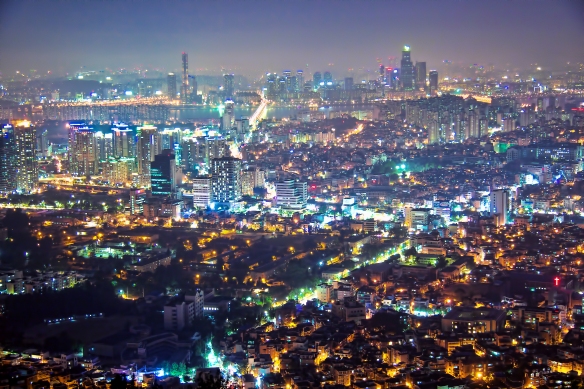Here we go again. On September 11th, satellite photos were released showing steam rising from the towers at Yongbyon, one of North Korea’s nuclear research facilities. On the 17th, the country failed to answer or provide evidence that rebutted a special UN human rights report report accusing it of “unspeakable atrocities”. On the 21st Kim Jong Un cancelled plans to allow hundreds of families split between North and South since the Korean War to be reunited at the Diamond Mountain resort in the North. Quite the active ten days for the Kim regime. These are just the latest in a long history of bellicosity and blatant disregard for international law.
 The Yongbyong nuclear research facility
The Yongbyong nuclear research facility
This confrontational attitude is made more interesting in contrast to Pyongyang’s recent “charm offensive”, where the country seemed increasingly willing to engage diplomatically. There was noise about restarting 6 party talks with denuclearization on the table, and Seoul had high hopes for the family reunification program. On September 2nd South Korea promised extra aid as a conciliatory gesture on account of improving relations, and on September 16th the joint industrial park at Kaesong was finally reopened following a 4 month hiatus. All of these positive steps have been wiped out in one fell swoop following the recent shift in tone.
 Entrance to the Kaesong Industrial Complex
Entrance to the Kaesong Industrial Complex
So, what gives? Why restart a globally condemned nuclear research program, further enrage human rights activists, and stonewall efforts to thaw relations just when the international community is beginning to respond positively to its overtures?
It turns out, in fact, that this is a trend. The North Korean leadership isn’t stupid, it isn’t naive, and it certainly isn’t irrational. For decades senior officials in Pyongyang have walked a diplomatic tightrope as they try to squeeze maximum aid out of friends and foes alike. The strategy is this: provoke for a period, but make sure not to step too far out of line. After all, provocation is a useful tool only if it doesn’t land you in a war with the world’s remaining superpower and its allies. Once the others have gotten themselves worked up over these actions, (the sorts of things that gets North Korea lumped into the so-called “axis of evil”), offer to come to the bargaining table in return for no-strings-attached foreign assistance ensues. Rinse, wash, and repeat.
Aid is absolutely necessary for the regime’s survival. The DPRK’s economy has long ceased to be capable of supporting its own population. Assistance not only prevents vast swathes of the population from starving, but also helps to consolidate political control. Provided without distribution conditions, these supplies of food, fuel, and industrial equipment are allocated according to an individual’s loyalty. Kim Jong Un strengthens his control by rewarding those who are and withholding from those who are not.
Up until the early 90’s it was easy to secure enough aid to go around, even without the provocational attitude we see today. Pyongyang skillfully played China and the Soviet Union off of each other; despite their common affinity for Marxist ideology, differing strategic interests and personal acrimony meant that the two countries were never really allies, and came close to war several times. Like two jealous parents aiming to earn the loyalty of an only child, North Korea exploited this animosity to secure aid from both countries in ever-increasing amounts.
Many North Koreans actually look back with fondness on this period during the 1980’s under the rule of the “Great Leader” Kim Il-sung; the Public Distribution System that handed out rations always had enough rice and grain, and people would only go hungry only through disloyalty to the regime, not because it couldn’t afford to feed them.
However, with the collapse of the Soviet Bloc also came the collapse of aid to North Korea. Russia was in disarray, and while China would still help to some extent although their interests had shifted as they initiated their own market reforms. Within a few years the country was destitute, and a horrific famine endured for much of the decade. The only way the country could survive was to extract as much aid from China and others, but without the leverage of its rivalry with the Soviet Union. Ironically, the countries that are the targets of the harshest North Korean propaganda – Japan, South Korea, and America – were in fact the countries whose aid prevented the death of even more North Koreans during this time.
Given this background, what should the US and its allies do to best improve the lives of North Korean citizens and promote stability in a rapidly growing region?
According to Andrei Lankov, a specialist in Korean Studies at Kookmin University in Seoul, the best strategy is to expose as many North Koreans to information about the outside world as possible, then simply wait. Most Korean strategists believe regime collapse is inevitable. The only question is how long Kim Jong-un or his successor can hold on. In today’s global reality, even state-sanctioned activities threaten to destabilise the country.
The North’s Kaesong Industrial Complex, which provides 123 South Korean companies access to the cheap labor of 53,000 North Korean workers, illustrates the pressures currently facing Mr. Kim and his advisors. Kaesong has been both a great blessing and curse to Pyongyang. It is a critical source of hard currency; $90 million a year flows into North Korean government coffers in return for its citizens’ labour, and is used to import fuel, food, and military equipment.
However it also exposes workers and their families in the Kaesong region, around 200,000 in total, to South Korean culture and products. Strict regulations are of course in place that carefully regulate what can and cannot be said or shown to workers, but even the factory buildings themselves speak volumes about just how much more advanced the South is.
This exposure presents a threat on multiple fronts; ordinary North Koreans are becoming more aware of the deficiencies that they have been enduring for decades, but simultaneously see an increases in their standard of living. When survival ceases to be a primary concern, individuals are able to think, to talk, and to organise. This is the stuff of nightmares for the Kim family. A population aware of the world beyond their borders and able to rally itself means almost certain downfall for the regime.
 Ordinary citizens are forced to work on large infrastructure projects
Ordinary citizens are forced to work on large infrastructure projects
Already there are signs that even those without the privilege of working at Kaesong know more about the outside world than at any other time, and are increasingly willing to speak out about it. The current generation of youth will be the first in the country’s history that grows up with the universal knowledge that they are being fed a lie by their government. Smuggled movies and music that show life in South Korea; cell phones with which they can call relatives in China; computers that can be used to read and hide Western literature and news. These are all increasingly common ways in which the government is losing control over its population.
This new-found propensity to flaunt the rules doesn’t just stop there, however. There have been several instances of protest in the past decade. In 2009 hundreds of middle-aged women clashed with police after the government attempted to initiate a clamp-down on the local markets which now form the backbone of economic life in the country. The government couldn’t make the restrictions stick.
In 2011 news reports trickled out announcing that for the first time ever, citizens in several major cities joined together in organised protests against the government demanding food and electricity. They were immediately repressed, but when the state authorities tried to identify the organisers, they were met with silence. As far back as the late 90’s, the combination of a huge network of paid informants and the social pressure to oust disloyal neighbors would have surely led authorities to the guilty parties. People are no longer beholden to the state in the way they once were.
The government’s control over its people in North Korea is rapidly diminishing as it fails to balance its need for foreign investment, the personal greed of the country’s elite, and the ease with which modern technology disseminates information. Perhaps the modern world makes it simply impossible to maintain control to the same extent as it was in the past. Either way, it is in nobody’s best interest to react with aggression to North Korea’s latest desperate attempts to grab the attention of the international community and squeeze much-need aid out of interested parties.
Repeated provocations are hard to ignore, especially for those on the receiving end, like the South Koreans, but everyone stands to gain from such a strategy. In fact, encouraging cooperation despite such provocation will help to accelerate the downfall of the regime, and lead to a better life for the true victims of the current situation – the tens of millions of ordinary North Koreans who continue to endure the harshest of realities.
Originally posted on the Forward Forum blog




Out of interest, what do you think the strategic possibilities of the West are at that point? I guess you seem to mostly be arguing for internal collapse as the most likely outcome
Hi Curious –
Good question. Obviously it depends on how the regime falls – if it’s an Arab-spring type popular revolt, then given the way the political winds are blowing in the US and Europe at the moment, I doubt much direct action would be taken. I can see America swooping in to secure weapons facilities and the like, but a serious ground presence seems unlikely. A lot hinges on South Korea’s response – do they seek political reunification, or just try to compete with China to out-invest in the country after a period? A more worrying possibility is if China annexes the North directly; is the South comfortable with a Chinese presence so close to Seoul? The North, while friendly to Beijing, currently acts as a buffer at least…